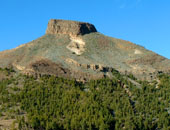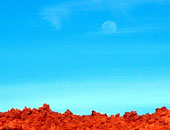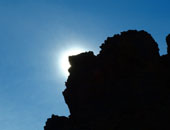
Bird List | Butterfly List | Photographs | Trip Reports | Home fssbirding.org.uk
Tenerife
Islas Canarias



10 - 16 April 2006
Observers:
F. Simpson & A. Simpson
|
|
|
|
|
Bird List | Butterfly List | Photographs | Trip Reports | Home fssbirding.org.uk |
|
Tenerife Islas Canarias |
|
|
10 - 16 April 2006 |
|
|
Observers: F. Simpson & A. Simpson |
|
INTRODUCTION
This was a specialist trip to observe the endemic birds found nowhere else on the planet but Tenerife or the other Atlantic islands which comprise Macaronesia (Canary Islands, Azores, Madeira and Cape Verde Islands). Within the Canary Islands, seven of the eight currently recognised endemic bird species are easily found on Tenerife. It's possible that the local races of Blue Tit and Chaffinch may receive the status of full species in the future. Due to the distance from the African and European continents, combined with the lack of freshwater, the species richness is low on Tenerife. I found 54 species without trying too hard and the main intention was to see the specialities well. With at least 14 Western Palearctic species (ok, ticks!) available for me here and the island races of common birds like Great Spotted Woodpecker and Robin worth a second look, it was definitely going to be an exciting Easter trip. There is plenty of birding information available in the form of trips reports and books so this short report will add nothing new. The access at some sites has changed and I have noted this accordingly. I found that a week was perhaps a little on the long side and three days would have sufficed. In retrospect, taking the boat to Fuerteventura for the second half of the week for Fuerteventura Chat (the other Canary Islands endemic) and fuerteventura Houbara Bustard would have been more efficient in the long run. Well, I guess that leaves another possibility for the future.
Normally I prefer to camp on holiday for the back-to-nature experience. However, with no camp sites on the island and wild camping illegal the cheapest and easiest option was to book a combined flight (BA) and apartment (Golf del Sur resort - not particularly attractive) on lastminute.com for around £300... it was the Easter weekend after all. Hired a car through Hertz for about £90 which turned out to be an old clio. The only thing going for it was its efficient fuel consumption and I used just three quarters of a tank of diesel. The local food is good here if you avoid the sad places proudly claiming to serve just British food or English breakfasts.
|
HIGHLIGHTS
Bolle's Pigeon · Laurel Pigeon · Blue Chaffinch · Berthelot's Pipit · Plain Swift · Atlantic Canary · Canary Islands Kinglet · Canary Islands Chiffchaff · Little Shearwater · Tenerife Blue Tit · Barbary Partridge · Trumpeter Finch · Barbary Falcon
|
LITERATURE, REFERENCES & ONLINE RESOURCES
• García
del Rey, E. 2000. Where To Watch Birds in Tenerife. Turquesa
Ediciones.
• Tenerife
Island Map 1:50000. AA Island Series 11.
• Svensson, L. et al. 1999. Bird Guide.
HarperCollins.
• Tolman, T. & Lewington, R. 1997. Butterflies of
Britain & Europe. Collins.
• Arnold,
N. & Ovenden, D. 2004. A Field Guide to the Reptiles and
Amphibians of Britain & Europe. Collins.
• Askew, R.R. 2004. The Dragonflies of Europe. Harley Books.
• Bramwell, D. 1997. Flora of the Canary Islands:
Pocket Guide. Editorial Rueda.
|
ITINERARY
Day 01 09/04/06 London
Gatwick > Aeropuerto Tenerife Sur Reina Sofia > Golf del Sur.
|
|
THE DIARY Day 1 Sunday
09 April 2006 London
Gatwick > Aeropuerto Tenerife Sur Reina Sofia > Golf del Sur
No birding today. The 1650 BA flight was delayed for four hours. Arrived at the hotel (Green Park, a few kms west of the airport) in Tenerife at 0200h on the Monday morning.
|
| Day 2 Monday
10
April 2006
HOTEL
GREEN PARK, GOLF DEL SUR
GOLF
DEL SUR > VILAFLOR
"THE
LEAKING PIPE" SITE
LAS
LAJAS
Tenerife Lizards (Gallotia galloti) were found at a high density and some were fairly approachable. Sometimes up to six were in view and just as we were discussing if they had any natural predators on the island, a Kestrel swooped down into a nearby clearing and briefly alighted on the ground before flying off. Later we observed a Kestrel flying overhead with a lizard in its grip! Several Canary Blue butterflies nectaring on a compositae flower. Also a pair of Turtle Doves and several Feral Rock Doves.
Blue Chaffinch (Fringilla teydea) · Canary Islands Kinglet (Regulus teneriffae) · Atlantic Canary (Serinus canaria)
STOP
ON ROAD TF-21
ABOVE THE TREE LINE AT GPS reading: 28º 12' 26 N 016º 40' 52
W
BOCA
DE TAUMA
STOP
ON ROAD TF-21
AT Km-51
LLANO
DE UCANA
PARADOR
NACIONAL DE LAS CAÑADAS At least six Berthelot's Pipits in the garden (of local plants) immediately outside the parador. Tenerife Lizards common and an unidentified small rodent scurried between cover.
DRIVE
BACK DOWN TO THE COAST Plain Swifts common below 1000 metres. Yellow-legged Gulls (6) above Arona.
Tenerife Lizard (Gallotia galloti) · Canary Islands Wallflower (Erysimum scoparim) · Canary Blue (Cyclyrius webbianus)
|
| Day 3 Tuesday 11
April 2006
HOTEL
GREEN PARK, GOLF DEL SUR
GOLF DEL SUR
> VILAFLOR (TF-563)
VILAFLOR
VILAFLOR
> LAS LAJAS (TF-21)
VIEWPOINT
ABOVE EL GORDO
LAS
LAJAS
LLANO
DE UCANA
Lava flows on Pico del Teide · El Llano de Ucana & Roques de García · Parque Nacional del Teide
MINAS
DE SAN JOSÉ
PALO
BLANCO > LAS LLANDAS > LADERA DE TIGAIA
MIRADOR
DE LA PIEDRA DE LA ROSA
EL
ROQUE, NEAR SAN MIGUEL
HOTEL
GREEN PARK, GOLF DEL SUR
Tenerife Blue Tit (Parus caeruleus teneriffae) · Berthelot's Pipit (Anthus berthelotii) · Great Spotted Woodpecker (Dendrocopus major canariensis)
|
| Day 4 Wednesday 12
April 2006 HOTEL
GREEN PARK, GOLF DEL SUR AUTOPISTA
DEL SUR > SANTIAGO DEL TEIDE > ERJOS ERJOS
> TRACK FROM VILLAGE TO THE FOREST
Canary Speckled Wood (Pararge xiphioides) · Houseleek (Crassulaceae) · Canary Cistus (Cistus symphytifolius) EROS
LAUREL FORESTS: MONTE DEL AGUA
Laurel Forest of Monte del Agua, Eros, Tenerife EROS
LAUREL FORESTS: LA CALABACERA > CLIFFS
Chaffinch (Fringilla coelebs tintillon) · Bolle's Pigeon (Columba bollii) · Grey Wagtail (Motacilla cinerea canariensis) Stopped at Restaurante Fleytas between Erjos and Santiago del Teide for some Rancho Canario (local soup) and cuttlefish.
|
| Day 5 Thursday 13
April 2006 HOTEL
GREEN PARK, GOLF DEL SUR PUNTA
DE ABONA
HOTEL
GREEN PARK, GOLF DEL SUR
|
| Day 6 Friday 14
April 2006 MONTAÑA
CHAYOFITA PARAJE
NATURAL MONTAÑA DE GUAZA PARAJE
NATURAL MONTAÑA DE GUAZA: MESAS DE GUAZA
Bath White (Pontia daplidice) · Canary Blue (Cyclyrius webbianus) · Southern Grey Shrike (Lanius meridionalis koenigi) GUARGACHO
RESERVOIRS Headed to the nearby polatzeki Lesser Short-toed Lark site along the track from the football pitch but the way was blocked with a private property sign and AS didn't want to get caught for a lark. PARAJE
NATURAL MONTAÑA ROJA
Cactus Spurge (Euphorbia canariensis) · Trumpeter Finch habitat, Montaña de Guaza · Purple-flowered Spurge (Euphorbia atropurpurea)
Went to Restaurante El Mirador in Los Abrigos for roasted Canarian goats cheese, Morcillas dulces (sweet blood sausage) and seafood.
|
| Day 7 Saturday 15
April 2006 HOTEL
GREEN PARK AMARILLO
GOLF CLUB EL
TANQUE > LOS SILOS PUNTA
DEL FRAILE
Cliffs in Teno Natural Park · Tenerife Lizard (Gallotia galloti) · Mist & Mountains in Teno Natural Park PUNTA
DE TENO TENO
ALTO TENO
ALTO > EL PALMAR MIRADOR
DE LA CRUZ DE HILDA SANTIAGO
DE TEIDE > GOLF DEL SUR
Goat at Teno Alto · Mist over Teno Alto · Rock Sparrow habitat at Teno Alto
|
| Day 8 Sunday 16
April 2006 HOTEL
GREEN PARK, GOLF DEL SUR EL
FRAILE RESERVOIR GUARGACHO Upper reservoir opposite the small church. Little Ringed Plover (2), Little Egret (1), Grey Wagtail and several Spanish Sparrows nesting in a nearby building. AMARILLO
GOLF COURSE Artificial rock-lined pool at the 15th opposite the club house. Scarlet Dragonfly (5+); some in tandem and some oviposting on the edge of the floating litter. The nearby LST Lark site has been trashed with a new road and piles of rubble - just a tiny fragment of suitable looking habitat left. PUNTA
DE ABONA
Abona area · Canarian Bean-Caper (Zygophyllum fontanesii) on the rocks · Faro de Abona AREA
NORTH OF THE AIRPORT AROUND THE CHICKEN AND OSTRICH FARMS AIRPORT
CAR PARK TENERIFE
> LONDON GATWICK
|
| SPECIES LIST - TENERIFE - 09-16 Apr 2006
|
|
BUTTERFLY LIST - TENERIFE - 09-16 Apr 2006
DRAGONFLY LIST - TENERIFE 09-16 Apr 2006
All photographs © 2006 F. S. Simpson Fraser's Birding Website · fssbirding.org.uk |
||||||||||||||||||||||||||||||||||